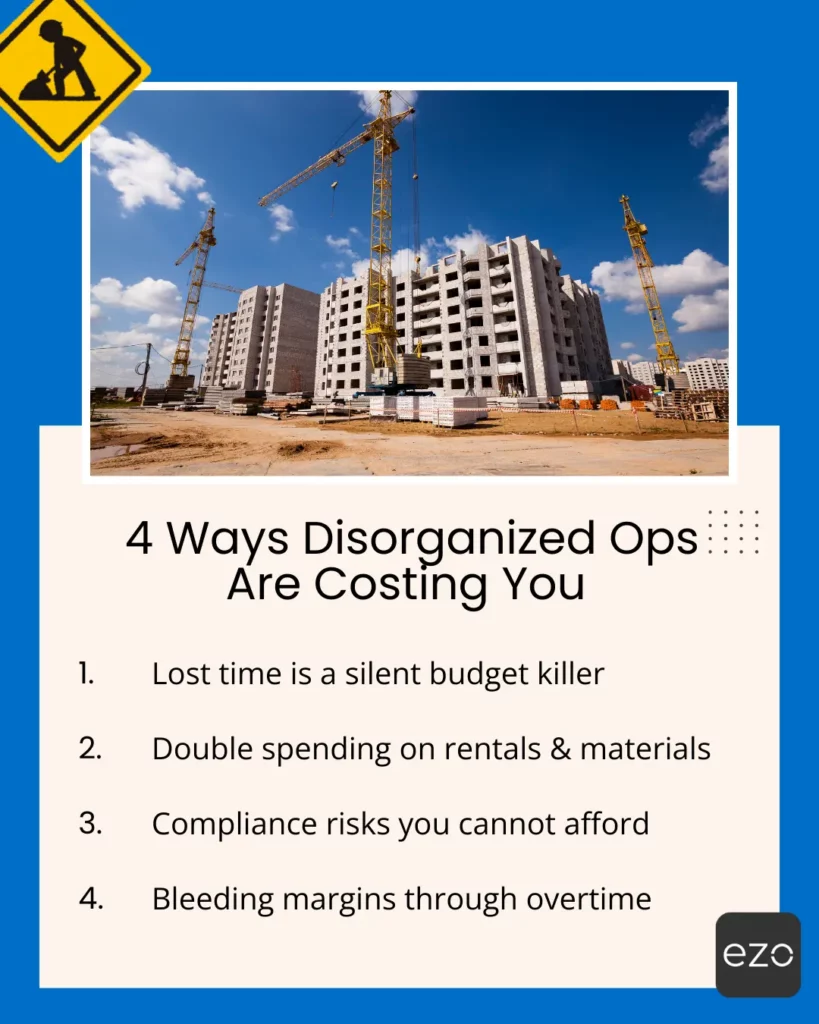By 4:10 p.m., the pour finished 90 minutes late. The day’s ledger on a construction site shows the real story: ~$2,500 in idle labor, two extra truck hours, a rescheduled inspector, and a rental extension on one skid steer that never touched the slab. This wasn’t a “bad day”. It was a preventable visibility problem. Where did the money leak?
Lost equipment, forgotten machinery, and overtime labor can amount to much more than just a scheduling hiccup. Disorganized equipment ops on construction sites typically have a domino effect, leading to missed deadlines and delayed milestones that eventually drive up costs. As a result, the next project is pushed out, messing up all the timelines set for labor and machinery.
End result? Budget drains combine with weaker bids for future projects. Project managers and operations managers are left with some serious explaining to do to their higher-ups. In this blog, we help you uncover the real costs of disorganized equipment ops on construction sites and what they’re actually costing you.
In this article, we’ll break down the four biggest costs of disorganized equipment management in construction and how to fix them.
1. Lost time is the silent budget killer
Low productivity creeps in silently when crews are left waiting for misplaced gear, overbooked machines, or late deliveries. Picture this, your crew arrives early in the day to start work all hyped up, only to find out that the team is still waiting for the skid steer to start the workday.
A little delay goes a long way and sets back more than just time. It’s no surprise that labor is usually the biggest cost in your budget for construction projects so naturally idle labor = wasted money plus workhours.
According to a study, crews spend around 14 hours per week in non-optimal activities on the construction site. These activities include time spent on unnecessary retrievals of information data, conflict resolution, and reworks.
While the crew is stalled, project managers like you are left scrambling to adjust last-minute scheduling changes to keep the work going. What starts off as a simple mistake of not updating the equipment records may build up to financial stress and budget drains.
2. Double spending on rentals and material
Disorganized equipment ops on the job-site always comes with a cost. You’re running on the clock and every minute you spend waiting for misplaced equipment to be located costs you money.
As a quick fix, you decide to rent the very machine your team is waiting on to keep the workday going. A one-time rental fee may not seem so big in your overall budget so you ignore it, until it becomes a frequent thing with item rentals making a significant part of your overall project spend.
Case Study: How rental costs spiral without equipment visibility
A subcontractor is unsure whether the boom lift owned by them will be available at a specific jobsite when needed. Rather than confirming its most recent availability, they rent a new one “just in case”.
Rental Cost Breakdown:
- Typical rental rates for boom lifts vary by type and height:
| Articulating boom lifts | Approximately $200–$700 per day |
| Telescopic boom lifts | $250–$1,500 per day |
Over a two-day rental in a pinch, that adds up to ~$1,040–$1,950 per day—easily $800–$1,200 more than if the lift had been scheduled properly. Meanwhile, the company-owned boom lift is sitting unused on another site, representing sunk cost and idle asset value.
How does it end? It doesn’t. You see the money bleed but don’t have the data to prove it. Without a solid way to keep equipment organized there is little chance you will be able to stop unexpected rental costs.
See how EZO prevents double or conflicting reservations with the availability calendar.
Avoid Booking Conflicts
3. Safety and compliance risks from poor equipment tracking
Occupational Safety and Health Organization (OSHA) mandates regular inspections for all construction equipment. It’s difficult to meet regulations when the majority of your records live in outdated spreadsheets and paper-based request forms.
One missed checklist can cost you huge fines.
On top of financial distress, you are liable to lawsuits if your machinery is not up to the industry standards. Unsafe or broken equipment slips back into the work site when you fail to schedule maintenance sessions due to lack of records.
A single tripload, injury, or a machine failure can trigger insurance claims, squeezing through already tight profit margins. OSHA compliance fines can exceed $16,500 per violation (OSHA, 2025). Disorganized records put you at risk.
It doesn’t just stop there. A single accident or failure can lead to reputational damage for years to come. Failed inspections can damage relationships with contractors and put you in a disadvantaged position for future bids; which is something you don’t want to experience in the construction industry.
And who is left to pick the blame? Project managers are ultimately tasked with managing insurance expenses and non-compliance safety risks on site, whilst bearing the brunt of cost burden stemming from legal non-compliance.
4. Bleeding margins through overtime
A single missing skid steer can snowball into hours of wasted calls, schedule reshuffling, and crews left standing idle. To recover lost productivity, many projects rely on overtime but the overtime costs in construction equipment management quickly erode profit margins.
On the surface, extra hours may look like a quick fix. In reality, they create a chain reaction of compounding expenses:
- Idle labor turns into overtime: Crews wait unpaid during the day, then rack up premium rates after hours.
- Fatigue sets in: Overworked teams are less productive and more error-prone.
- Mistakes escalate into rework: Quality slips, requiring costly do-overs.
- Safety risks rise: Tired crews are more likely to cause accidents, increasing liability and insurance claims.
- Margins bleed: Payroll costs climb while morale drops, turnover rises, and future projects slow down.

What feels like “making up for lost time” often results in paying more for less output, while exposing your projects to unnecessary risk.
11 daily signs your equipment ops are out of control
Disorganized equipment ops don’t necessarily make one dramatic entrance but can be seen slowly creeping into your daily work routines. Frustrated crew members, missing machinery, and doubling down on rentals are red flags that can be easily dismissed as part of the construction grind.
But it shouldn’t be. Here are some daily signs to look out for that can indicate the systematic cracks in your equipment management style:
- The 6 a.m. fire drill. Foremen calling before sunrise: “Where’s the lift?” You start the day chasing equipment, instead of executing the already delayed project.
- Idle crews on the clock. Teams standing around while waiting on gear, deliveries, or instructions, inevitably burning payroll with nothing to show for it.
- Rental bills creep higher. “Just in case” rentals become the norm, even though owned equipment is sitting idle somewhere else.
- Maintenance records scattered everywhere or nowhere. Paper binders in the shop, spreadsheets in email, sticky notes in toolboxes. That’s how you keep all your records, less consistency → more risk.
- Phone calls and text chains are your “logging system.” If WhatsApp groups and back-and-forth texts are your source of truth, breakdowns—both in equipment and communication—are inevitable.
- Duplicate equipment purchases. A skid steer is ordered because the team assumes the fleet is maxed out. It’s later discovered that two unused units were parked behind another site office.
- Surprise breakdowns in the field. Preventable failures happen because inspections were missed or maintenance wasn’t scheduled on time.
- Conflicting schedules. Two crews show up expecting the same machine. One ends up idle, the other improvises unsafely, and the project slips behind.
- Reactive overtime. Overtime spikes to make up for lost time. Fail to realize that fatigue drives productivity down another 20–30%. You end up paying more to the crews for less.
- Finger-pointing over ownership. No one knows who had the machine last, who logged the inspection, or who’s accountable for missing equipment.
- Constant firefighting. Project and Ops Managers spend their days reacting to crises instead of focusing on planning, efficiency, and client comms or relationships.
Ready to check whether you’re running organized equipment ops? Try out checklist
What organized equipment operations look like (And why it matters in construction)
Disorganized equipment management doesn’t just delay schedules — it eats into margins, creates compliance risks, and frustrates crews. By contrast, organized equipment operations in construction give project managers and field teams the control they need to stay on time and under budget.
Here’s what effective equipment management looks like when done right:
1. Centralized visibility and tracking
A single construction equipment tracking system consolidates all tools and machinery into one source of truth. Bookings are scheduled in advance to avoid conflicts, and every piece of equipment is tagged to a specific crew or site.
This ensures foremen always know who has what, where, and when, reducing the risk of misplaced tools and idle assets.
2. Preventive maintenance as margin protection
Preventive maintenance scheduling protects jobsite safety and bottom lines. Regular inspections and service intervals lower the risk of surprise breakdowns that stall progress. According to industry research, companies save 12–18% in annual equipment costs through preventive programs compared to reactive fixes.
3. Structure dispatch and returns
When equipment moves between the yard and multiple jobsites, dispatch and return logs prevent double bookings and “lost” machinery. Clear digital workflows mean that every machine is signed out, transported, and logged back in, minimizing confusion and eliminating ghost rentals.
4. Mobile access in the field
Superintendents and foremen can’t afford to wait for emails or phone confirmations. Mobile equipment management apps allow them to request or release machinery instantly from the field. A skid steer can be dispatched at the tap of a button, ensuring crews start work without delay.
Organized equipment ops cut the unnecessary back and forth and make work easier for both crews and project managers.
| Disorganized Ops | Organized Ops |
| Crews waiting for tools or machines → idle labor costs climb | Crews know exactly where equipment is → work starts on time |
| Duplicate rentals because owned equipment can’t be located | Centralized visibility → no unnecessary rentals or purchases |
| Maintenance tracked in paper binders → missed inspections, surprise breakdowns | Preventive maintenance scheduled digitally → fewer breakdowns, longer asset life |
| Dispatch handled via calls/texts → machines double-booked or misplaced | Structured dispatch and return logs → clear chain of custody |
| Project managers firefighting daily crises → margins shrink | Managers focus on planning and protecting margins |
| Safety risks rise due to poor inspection records | Compliance and OSHA standards met with digital checklists |
| Morale suffers as crews face constant delays and rework | Crews stay productive, turnover and overtime reduced |
See a step-by-step guide to organized equipment operations
The project manager’s hidden lever: visibility and control
Disorganized equipment ops just doesn’t end at a few extra rental dollars or hours lost on the job-site. They slowly drain profit, stretch timelines and chip away at margins through overtime. You may think all this chaos is above and beyond your control.
But that’s not entirely true. You have more control than you realize.
Make the right decision to invest in an equipment tracking system to tighten up control over tools and machines. Visibility into equipment will give you control over operations that can help you cut back on budget leaks.
Ready to transform your equipment ops? Sign up for a free trial at EZO to get your equipment ops sorted.
Was this helpful?
- 1. Lost time is the silent budget killer
- 2. Double spending on rentals and material
- 3. Safety and compliance risks from poor equipment tracking
- 4. Bleeding margins through overtime
- 11 daily signs your equipment ops are out of control
- What organized equipment operations look like (And why it matters in construction)
- The project manager’s hidden lever: visibility and control









